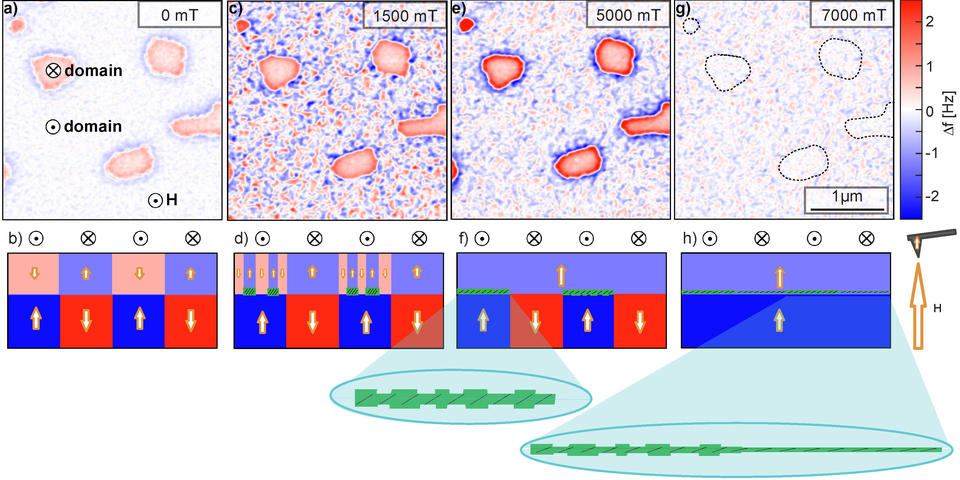Heat-assisted magnetic recording in bit-patterned media is one of the technologies that could possibly raise areal densities to several tens of Tb/in2. In the ongoing development of concepts for such technology, exchange cou-pled double-layer structures can provide useful design flexibility, as variously discussed1,2,3. Here we discuss TbFe/[Co/Pt]n based systems, for which conveniently the Curie temperature (TC) of TbFe can be tuned within 400-600K with composition and suitable addition of Co. Advantageously, TC is considerably smaller than that of L10-FePt. The [Co/Pt]n multilayer has high TC and large magnetization, and hence couples well to an external field and provides a strong stray field for reading.
In these systems it is important to understand the reversal mechanism locally, but combining high magnetic reso-lution (< 10nm) with fields of several T is difficult. We accomplish this with quantitative magnetic force micros-copy (MFM). Fig. a) shows the as-grown bilayer in 0 T. Magnetometry and comparing MFM data with simula-tions indicate antiferromagnetic coupling of TbFe and [Co/Pt]5 [Fig. b)]. For an applied field of 1.5 T (up direction), a pattern of sub-domains appears within the [Co/Pt]5 domain with initially down-magnetization [Fig. c)]. The sub-domains contribute up-magnetization and form domain walls parallel to the TbFe/[Co/Pt]5 interface (iDW)4 [Fig. d)]. The nucleation of these sub-domains is consistent with inhomogeneous interfacial exchange coupling, and a correspondingly inhomogeneous thickness of the iDW. Due to the strong exchange-coupling5,6 the magnetic moments of [Co/Pt]5 align with the field, except within the interfacial wall. The MFM signal re-flects TbFe domains and variations of the iDW thickness which decreases with increasing field, but remains vis-ible even in 5 T [Figs. e) and f)]. In 7 T, above the TbFe coercivity of about 5.5 T, the film is saturated [Fig. g)]. Surprisingly, the magnetic roughness at the locations of initial [Co/Pt]n up-domains [dashed lines in Fig. g)] is lower than that outside these areas [Fig. h)].

- R. Mattheis and K. Steenbeck, J. Appl. Phys., 97, 10K107 (2005).
- R.F.L. Evans, R. Yanes, O. Mryasov, R.W. Chantrell, and O. Chubykalo-Fesenko, Europhys. Lett., 88, 57004 (2009).
- V. Skumryev, S. Stoyanov, Y. Zhang, et al., Beating the superparamagnetic limit with exchange bias, Nature, 423(6942): 850-853 (2003).
- S. M. Watson, T. Hauet, J. A. Borchers, S. Mangin, and E. E. Fullerton, Appl. Phys. Lett., 92(20):202507 (2008).
- C. C. Lin, C. H. Lai, R. F. Jiang, H. P. D. Shieh, J. Appl. Phys., 93(10): 6832-6834 (2003).
- S. Romer, M. A. Marioni, K. Thorwarth, N. R. Joshi, C. E. Corticelli, H. J. Hug, S. Oezer, M. Parlinska- Wojtan, and H. Rohrmann, Appl. Phys. Lett., 101(22):222404 (2012).
Authors
Xue Zhao1, Johannes Schwenk2, Andrada-Oana Mandru1, Miguel A. Marioni1, and Hans J. Hug1,2
1 Empa, Swiss Federal Laboratories for Materials Science and Technology, CH-8600 Dübendorf, Switzerland.
2Department of Physics, University of Basel, CH-4056 Basel, Switzerland.
Xue Zhao
EMPA

